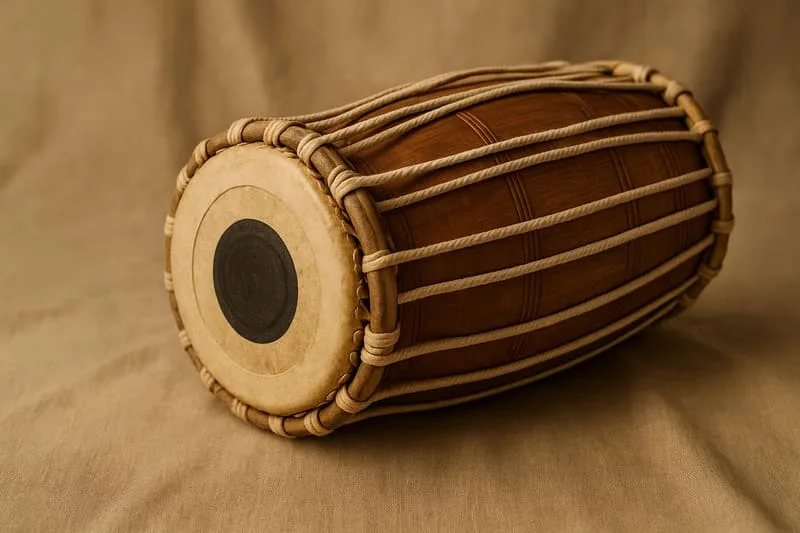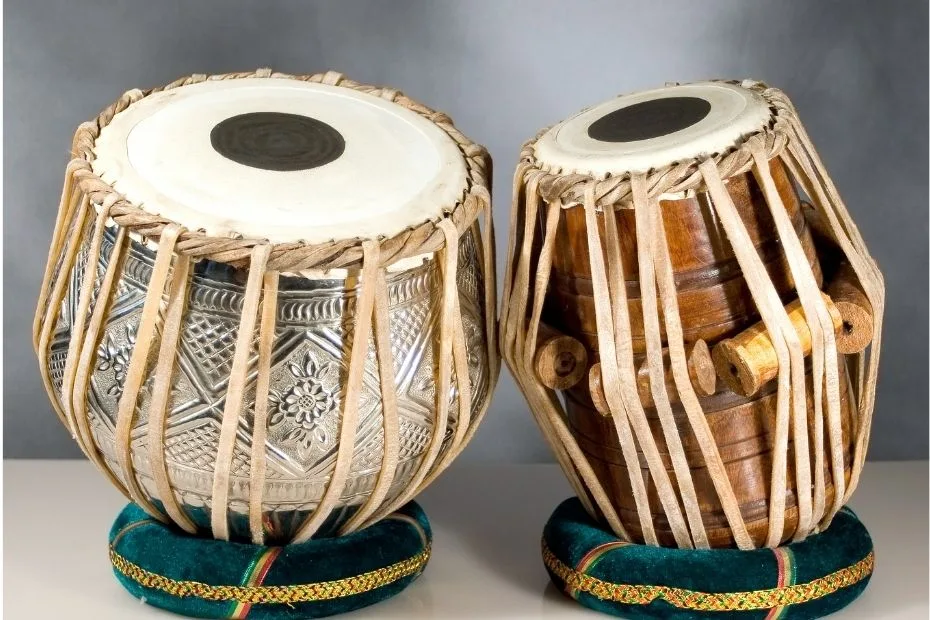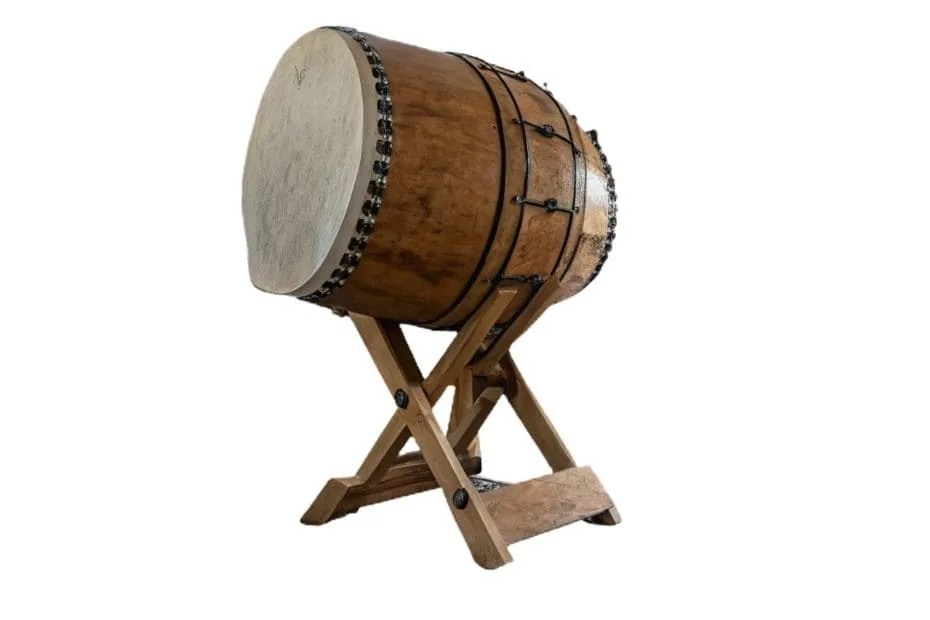The Pakhawaj is the grand, resonant barrel drum that anchors the ancient Dhrupad tradition and many temple and folk styles of North India. With its thunderous bass, crystalline treble, and lyrical phrasing, the Pakhawaj is both a rhythmic engine and a storytelling instrument. If you’re curious about its sound, construction, repertoire, or how to choose one, this guide brings you everything you need—crafted for musicians, students, and enthusiasts alike.
Pakhawaj at a Glance: Key Features and Specs
| Feature | Details |
|---|---|
| Type | Indian barrel drum, double-headed, laced |
| Body Wood | Sheesham (Indian rosewood), Teak, Jackwood; one-piece turned shell |
| Heads | Goat/calf skin with syahi (black tuning paste) on treble; bass often tuned with removable dough (atta) |
| Typical Length | 50–66 cm (20–26 in) |
| Head Diameters | Right/treble: 14–19 cm (5.5–7.5 in); Left/bass: 23–27 cm (9–10.5 in) |
| Tuning Range | Treble tuned to the tonic or dominant of the ensemble; bass adjusted with dough during performance |
| Genres | Dhrupad, Dhamar, Haveli Sangeet; also folk and temple repertoires |
| Common Talas | Chautal (12), Dhamar (14), Sooltal (10), Teevra (7), Matta (9) |
What Is the Pakhawaj?
The Pakhawaj is a double-headed drum and a direct ancestor of the tabla. It is held horizontally across the lap, with the larger bass head to the player’s left and the smaller treble head to the right. Its voice balances power with nuance: a growling, temple-like bass and a focused, bell-like treble. Historically, it’s the rhythmic pillar of Dhrupad—the oldest surviving form of North Indian classical music—supporting meditative alap and stately compositions with intricate yet unhurried rhythms.
Anatomy and Construction
The Pakhawaj’s shell is typically carved from a single block of dense hardwood. Sheesham produces a bright, projecting tone, while Jackwood and Teak can sound warmer and more rounded. The heads are laced with long rawhide straps that pass through hide hoops. Small wooden wedges—called gatta—are inserted beneath the straps to fine-tune tension.
Heads and Syahi
– Treble (Right) Head: Fitted with a central black spot, the syahi, a composite of iron filings, ash, gum, and other adhesives that focuses pitch and overtones.
– Bass (Left) Head: Often without permanent syahi; players apply a temporary dough paste (atta) to lower the pitch and add bloom to the bass. Some variants do include a thin syahi for a more stable, darker tone.
Typical Sizes and Weight
Length spans 50–66 cm, with head diameters around 14–19 cm (treble) and 23–27 cm (bass). A concert-quality Pakhawaj can weigh 5–9 kg, depending on wood density and shell thickness.
Sound, Tuning, and Tonal Character
The treble head is commonly tuned to the vocalist’s tonic (Sa) or fifth (Pa). Because of the syahi, the treble produces crisp, ringing strokes like Na and Ta. The bass head, resonant and cavernous, is shaped in real time by the amount and placement of atta, yielding strokes such as Ge, Ka, and the combined Dha.
How Tuning Works
– Use a small hammer to tap the gatta (wedges) and equalize strap tension.
– Fine-tune the treble by adjusting individual lacing points and testing reference pitches.
– Shape the bass by applying more or less dough; thinner layers yield a higher, tighter bass, while thicker applications deepen the note and lengthen sustain.
Technique and Signature Bols
Pakhawaj technique prioritizes clarity, weight, and a singing resonance. The instrument rests on a ring cushion or folded cloth, the player seated cross-legged. Both palms, fingers, and wrists articulate a vocabulary of bols (mnemonic syllables): Dha, Dhin, Ge, Na, Ta, Te, Tin, Tun, Ka.
Compositional Forms
– Peshkar: Expansive, improvisatory opening exploring tone and motif.
– Paran: Powerful compositions often echoing dance syllables.
– Rela: Flowing, fast passages with motoric drive.
– Chakradar: A composition repeated thrice to resolve precisely on the sam (downbeat).
Core Talas in the Pakhawaj Repertoire
– Chautal (12 beats): 2-2-2-2-2-2; the quintessential Dhrupad cycle.
– Dhamar (14 beats): 5-2-3-4; associated with Dhamar/Hori songs.
– Sooltal (10 beats): Symmetrical and stately.
– Teevra (7), Matta (9), and regional cycles that showcase the drum’s architectural phrasing.
Pakhawaj vs. Mridangam: What’s the Difference?
While both are barrel drums, the Pakhawaj belongs to North Indian traditions, and the Mridangam to South Indian Carnatic music. The Mridangam uses a different head loading (with permanent paste on both sides), tends to a tighter, more articulated sound ideal for Carnatic phrasing, and employs distinct bols and talas. The Pakhawaj favors broad resonance and the Dhrupad idiom, with dough-tuned bass and expansive peshkar-led architecture.
How to Choose a Pakhawaj
1) Wood and Build
– Sheesham: Bright attack, strong projection, durable—great for stage.
– Jackwood/Teak: Slightly warmer, rounded tone—lovely for recordings and intimate venues.
– Look for a one-piece shell with even wall thickness, clean bearing edges, and neatly mounted heads.
2) Size and Pitch
– For vocal accompaniment, many players prefer a treble tuned around C♯–E (instrument-dependent).
– If you are taller or prefer deeper bass bloom, consider a slightly longer shell and a larger bass head (e.g., 10–10.5 in).
3) Hardware and Lacing
Quality rawhide straps should be supple yet strong. Ensure gatta wedges seat firmly without splintering. Check that both heads are seated evenly and that the syahi is perfectly centered with no cracks.
4) Test the Voice
Play slow peshkar phrases: listen for a long, even sustain on bass (Ge) and a clear, bell-like treble (Na, Ta). The combined Dha should feel unified, not two disjointed sounds.
Care, Maintenance, and Seasonal Tips
– Climate Control: Wood and heads react to humidity. Keep the drum in a breathable case with silica packets. Avoid direct sun and rapid temperature shifts.
– Head Health: Lightly condition straps with appropriate leather care (sparingly). Do not over-wet heads; use a barely damp cloth to clean dust.
– Syahi Care: Never scrape the syahi. If micro-cracks appear, consult a specialist head-maker (pudi artisan).
– Atta Usage: Use fresh dough each session; remove completely afterward to prevent mold. Wipe the bass head clean and air-dry.
– Storage: Rest on a ring cushion; do not hang by straps. Loosen tension slightly in very dry seasons to reduce stress on the shell.
Notable Artists to Explore
To understand the Pakhawaj’s breadth, listen to maestros such as Ramakant Deshpande, Bhagwan Das, Shri Mohan Shyam Sharma, Pandit Dhruv Nath Mishra, and collaborations with great Dhrupad vocalists from the Dagar lineage. Their recordings illuminate tone production, tala architecture, and repertoire depth.
Learning Path: From First Strokes to Concert Stage
Start with Foundation
– Posture, hand placement, and producing clean Na, Ta, Ge, Dha.
– Slow practice with a Chautal theka; count aloud to internalize the cycle.
Build Repertoire
– Learn peshkar development, then paran, rela, and chakradar forms.
– Explore Dhamar (14) for festival pieces and Sooltal (10) for symmetry and control.
Refine Tone and Dynamics
– Experiment with atta thickness and placement for different halls or microphones.
– Practice meend-like bass glides by subtly adjusting finger pressure and dough area.
SEO Quick Tips for Buyers and Learners
If you’re researching online, helpful search terms include: Pakhawaj drum, buy Pakhawaj, Pakhawaj tuning, Dhrupad percussion, Pakhawaj lessons, and Pakhawaj vs Mridangam. Look for detailed listings that specify shell wood, head diameters, weight, and whether the instrument ships with a case, ring cushion, and tuning wedges.
Final Thoughts
The Pakhawaj is more than a drum—it is a bridge to centuries of North Indian musical thought. Whether you’re drawn to its meditative gravitas or its architectural rhythms, investing time in sound, posture, and tala literacy will reward you with an instrument that can thunder, sing, and whisper in equal measure.



